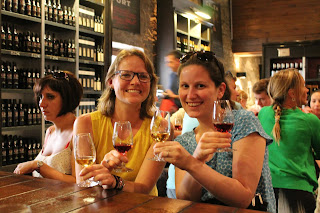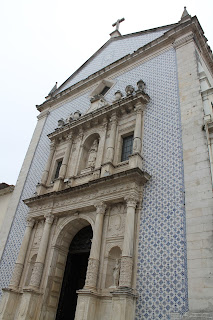Our first stop was in Porto, or Oporto, depending on what language you speak. I knew that this was a river port, so I was a little surprised when we first entered the city and saw neighborhoods that in no way looked like the photos I had seen on Trip Advisor. Our guide, Angela, explained that Portugal is by no means a wealthy country, and is worse off economically than Spain. As we walked away from our hotel, however, the scenery slowly started to change.
First, Angela took us to the cathedral. If anyone is keeping track of how many cathedrals I've visited on this trip, please let me know, because I have lost count.
There, she gave us a little history lesson. She explained that Porto had been the site where ships were built for Portuguese expeditions to the Americas. She also talked about how Portugal benefited greatly from an alliance with England that has lasted for several hundred years. She encouraged us to go inside the cathedral and take a look at the altar, which is made of silver and gold, and was the most valuable item in the city at the time of the Napoleonic invasion of Porto. Since it was too heavy to move, members of the church decided to construct a fake wall in front of it so that it wouldn't be completely plundered by French troops. The plan worked and the retablo is still standing today. I managed to get a photo of it from the back of the cathedral. I didn't want to get any closer, because as you can see, there was a wedding going on.
From the cathedral, we walked down the hill to Porto's main train station. At one time, the structure was part of a convent, but after the convent suffered a terrible fire, only a small shell of it was left. The remains of the building lay abandoned for a long time, until it was decided that it would make a good location for a train station. Porto had long been producing decorative tile in a multitude of colors, but when blue and white porcelain began to arrive from China for use by the aristocratic class by the early 16th century, locally made blue and white tiles became the most popular color combination among the rest of the population. The train station is a testament to this beautiful craftsmanship, and blue azulejo tiles can be found in and on buildings throughout Porto.
After continuing through the streets of Porto and visiting yet another church, Angela took us to the Lello & Irmão Bookstore, which was the inspiration for Hogwarts Library in the Harry Potter movies. It is such a popular tourist attraction that there is actually a line to get in! To me it was worth it, as the library was absolutely beautiful inside, and I had the chance to climb the gorgeous spiral staircase and wander amongst the stained glass-lit books as if I were Hermione.
After visiting the bookstore, our guide gave us free time until the following morning, so the ladies and I decided to make our way over to the river to have lunch and explore a bit. This is where I began to see sites similar to the images that I had come across online. We first found ourselves on the upper level of the Ponte Luis I, a double-decker bridge with cable car tracks on top and car traffic on the bottom.
From the cable car level, we had sweeping views of the river district.
The only question was, if we're up here, how do we get down there? We had our answer when we spotted this mildly terrifying contraption:
We rode the funicular down the steep hillside. I kept waiting for it to speed up like a roller coaster, but fortunately it never did.
Check out those tracks!
Once we were safely deposited at the bottom of the hill, we stopped at one of the many riverside restaurant terraces for lunch. I had croquetas do bacalao (cod fritters), and I tried some of Katie's Francesinha, a sauce-doused meat sandwich that is very typical of Porto. After lunch, we crossed the bottom level of the bridge so that we could get to the port cellars on the other side. Along the way, I noticed a bit of commotion. A group of young boys were entertaining the pedestrians by climbing along the outside of the lower level of the bridge and then jumping into the river. They did it more than once, so I was able to get a video of their second jump (you can ignore the second half, as it took me a minute to realize the camera was still filming, and Blogger won't let me upload the edited version.
We didn't waste much time in making our way from the bridge to the port cellars. We booked a tour an hour in advance at the Calem Bodega, then passed the time by stopping for a drink and exploring the open air market and carnival on that side of the river. When it came time for our tour, we learned all about the making of port wine. Wine can only be called Port if it has been harvested from grapes in the Duoro River valley and then produced locally. Originally, the grapes were harvested only by women and transported only by men, but now both genders share in the various steps of the harvesting process. Port is infused with additional alcohol, which stops the fermentation process and produces a very sweet - and much stronger - wine.
Thanks to the alliance with England that I mentioned earlier, port became a very popular drink for women among Britain's wealthier classes. For generations, men and women had retired to separate parlors after dinner so that men could enjoy their brandy and cigars, and women could gossip. With the arrival of port, women suddenly had a sweet dessert beverage that they could enjoy, too.
Our guide showed us the different port barrels that are currently in use. The large ones hold tens of thousands of gallons of ruby (sweeter) ports, while the smaller ones hold tawny (slightly drier and oakier) ports. The large barrels are used for 100 years and then are destroyed, while the small ones are used for 50-60 years and then sold to Scottish distilleries to aid in the production of whiskey.
Following the tour, everyone was allowed to taste two different types of port, a white variety and a tawny special reserve. In general, I found the port to be a bit too strong, but if I had to choose one to drink again, I would pick the white one.
(Katie and I appear to have been much more excited about the port tasting than the woman at the end of the table.)
After the conclusion of our port education experience, we wandered along the river a bit more before realizing that we would once again have to get to the top of the bridge in order to return to the hotel. This time, we decided to take a sky tram (In case anyone is wondering how many different forms of transportation are used in this small stretch of land and water, the answer is approximately nine).
Me and Irma
We paused for a final view of the river before picking up a light dinner in the center of town.
By that point, we were super tired and decided to split the cost of a cab back to the hotel. Our cab driver took off like a speed racer as soon as we got in the car, reaching 50 miles an hour on the narrow, winding, cobblestoned streets. We held on tight and tried not to appear too terrified. Fortunately, we made it back to the hotel safe and sound, and proceeded to enjoy a night in a room that didn't make us feel like we were sleeping in a sauna.
The next day, we departed our hotel at 9:00am and made our way to Aveiro for a two-hour visit. I was very excited when I read on Trip Advisor that Aveiro is "The Venice of Portugal", but then Katie informed me that Pittsburg is known as "The Venice of Pennsylvania", which made me worry that the comparison might have been thrown around a little too loosely. Aveiro was indeed full of little canals, and for eight euros, we took a 45 minute tour on motor-powered gondola to learn more about them. The guide spoke to us in Portuguese, but when he realized that we didn't understand what he was saying, he switched to English. I think I actually got more from the Portuguese version than the English one, but the gist was that Aveiro has been a producer of naturally collected sea salt for hundreds of years. Here are a few gems from the gondola tour and our subsequent walk around town.
Aveiro was charming in it's own unique way, although I'm still hoping to visit the real Venice some day.
When our two hours were up in Aveiro, we boarded the bus and drove a few minutes away to the nearest beach on the Atlantic Ocean. I set up camp in an area where some barriers created a protected bay, making for calmer waters and a much smaller crowd.
Mr. Duck stole my sunglasses and sunbathed for a bit.
I read, napped, and submerged myself in the frigidly cold water for a very brief period of time. Before leaving, I wandered over to see the beach on the other side of the barrier with more open waves, and I was glad that I had made my earlier decision to stay on the quieter side. Look at all those people!
Still, I couldn't resist the opportunity to dip my feet in the open Atlantic, facing west for a change.
All in all, it was a relaxing afternoon at the beach, and a fun-filled weekend in Portugal.
Now I'm back in Spain, preparing for my last full evening in Salamanca before leaving for Madrid tomorrow afternoon. I'll probably write another post later tonight about how the ladies and I decide to spend our last few hours of free time together. This trip has flown by so quickly!






























Looks like you're having an incredible time, Auds! So excited for you that you got this opportunity...Lord knows you deserve it!! Love the blog!
ReplyDeleteThanks, Val! It has been a great experience. I can't believe it's almost over!
Delete